|

 Up
Up 
 On to Ohio
On to Ohio 
(You are here.)



  Need
to Need
to
find your
bearings?
Try
these
navigation aids:
If
this is your first
visit, please stop by:
Something
to share?
Please:



|
|
Available in Française, Español, Português, Deutsch, Россию,
中文,
日本, and others.
Dan Wright Sr., 1757 to 1832
Dan Wright was born in Lebanon, Connecticut in
1757 and lost his father when he was just 4 years old. He joined the
Continental Army in 1777 and fought in the Revolutionary War. Family
tradition records that he “engaged in many battles,” but perhaps the
most important was the Battle of Saratoga in the autumn of 1777. It
was at this battle that the American patriots under the command of
Major General Horatio Gates forced the surrender of General John
Burgoyne and the northern division of the British army. In doing so,
they foiled a British plan to trap the Continental Army between
three divisions of the British. Many historians cite this as the
turning point when fortune finally began to favor the Americans in
their War for Independence. The victory at Saratoga also convinced
the French to ally with the new United States of America in
opposition to England.
After the War, Dan settled near Hanover,
Vermont, working as a carpenter and a farmer. In 1785, he married
Sarah Freeman. She was the daughter of Colonel Edmund Freeman,
another Continental soldier who had also participated in the Battle
of Saratoga. Freeman had been part of the New Hampshire militia. Dan
and Sarah had six children in Vermont – Asahel, Porter, Dan Jr.,
Sally (or Sarah), Elizabeth, and Samuel.
In 1814, Dan Sr. and his children decided to
move to the new state of Ohio, possibly to escape the uncertainties
of the War of 1812 which was raging in his neighborhood. The British
were using Montreal as a staging area and attempting to move troops and
supplies south through Vermont and upper state New York. A decisive engagement, the Battle of Lake Champlain,
occurred not far from the Wright farm.
Porter and Dan Jr. had left Hanover by this time and were living in
the Genesee Valley south of Rochester – what is now known as the
Finger Lakes district. Dan Sr. and the remaining family pulled up
stakes, made a short stop in Genesee Valley to pick up Porter and
Dan Jr., and moved to Ohio. They first settled in Centerville, just
south of Dayton, where Dan Sr.’s son Asahel set up a general store
and a small distillery. He also manufactured peppermint oil, which
was used as a medicine and a tonic at that time. Dan Sr. was
beginning to show his age and his children, especially Asahel,
looked after him and Sarah. Asahel helped set up his parents on a
small farm west of Centerville. In 1826, there were reports that the
National Road – the new nation’s first highway – would be passing
north of Dayton. Asahel sold his holdings in Centerville, including
the 25-acre farm where Dan Sr. lived, and moved the family to a farm
in Bethel Township in Miami County, where the National Road would
pass. There Asahel started another store. Construction of the
National Road was slow, but it finally arrived in 1838, running
along the northern property line of the Wright farm. Dan Sr. was
deceased by this time, having passed away in 1832.
Dan Wright Jr., 1790 to 1861
Dan Wright Jr. was born in Thetford , Vermont in
1790. He taught school in Vermont and then traveled to Genesee
Valley, New York where he stayed with his brother Porter for a time.
In 1814, Dan Jr. and Porter joined their father Dan Sr. and siblings Asahel, Elizabeth, Sarah, and Samuel as they emigrated to Ohio.
While in Centerville, Ohio Dan Jr. worked in his brother Asahel’s
distillery. He married Catherine Reeder in 1818 – Catharine was the
daughter of Margaret (Van Cleve) Reeder, whose family were among the
first settlers of Dayton, Ohio. They had two sons while still in
Centerville – Samuel Smith and Harvey.
In 1821, Dan Jr. and his wife
left Centerville for Indiana, The territory had become a state in
1817 and a year later the Treaty of St. Mary's had opened vast
tracts of land for settlement that had formerly belonged to the
natives. Of immense importance to Dan Jr., Indiana became a free
state in 1820 following the case of Polly vs. LaSalle which freed
Indiana slaves from their masters. Dan and Catharine staked a farm in Richland
Township, Rush County, and then moved to another Rush County farm in
1823, just a mile and a half southwest of their first Indiana home.
Here, Catherine bore two more sons and a daughter, Milton, William
and Sarah. There may have also been a son and a daughter who died in
infancy, George and Kate. Throughout his life, Dan Jr. remained
close to the extended Wright family and made numerous visits to his
father, mother, brothers, and sister in Miami County, Ohio.
Dan was a straight arrow who took his ethics
seriously. Later in life, Milton Wright described his father as
“grave in his countenance, collected in his manners, hesitating in
his speech, but very accurate.” The early 1800s was the time of the Second
Great Awakening, another burst of religious zeal and revival in
America. Dan Jr. apparently got religion in 1830 and became a
teetotaler – even though he had once worked in his brother’s
distillery – and refused to sell his corn crop to distillers who
would convert it to whiskey. Dan Jr. strongly supported the
abolition of slavery and opposed the activities of secret fraternal
societies such as the Masons. He apparently passed these beliefs on
to his son Milton along with his love of family.
In 1840, Dan Jr. sold the second Rush County
farm and moved to another just over the county line in Orange
Township, Fayette County, Indiana. He died at this farm in 1861.
Bishop Milton Wright, 1828
to 1917
Milton Wright was born in 1828 on his father’s
farm in Rush County, Indiana. He was a studious youngster, and was
encouraged in his studies by his two older brothers, Samuel Smith
and Harvey. Like his father, he was influenced by the tail end of Second Great
Awakening and determined to lead a religious life in 1843. However,
he did not formally join a church until 1847 when he became a United
Brethren. The Church of the United Brethren was the first completely
American religious sect and as such embodied many of the
equalitarian principles of the new nation. It was especially popular
in the Midwest and its unofficial headquarters were in Dayton, Ohio.
Milton moved quickly up the ranks. He took a
supervisory position at Hartsville College (a United Brethren
institution), was ordained a minister, served time as a missionary
in the gold fields of Oregon, and then returned to Indiana to become
a circuit preacher. He married
Susan Koerner in 1859 and the two of
them eventually had five children –
Reuchlin,
Lorin,
Wilbur,
Orville, and
Katharine. There was also a set of twins, Otis and Ida,
who died in infancy.
The Civil War loomed large in Milton’s early
life, but he did not fight even though he was unequivocally an
abolitionist. He was also a pacifist, so much so that he would not
preach to the troops. Strong opinions like these made Milton both an
influential and controversial figure in the Church of the United
Brethren. His career required that he move his family often. They
lived in three different locations in Indiana before Milton was
appointed the editor of the church newspaper in 1869 and moved to
Dayton, Ohio where the United Brethren maintained their printing
house. In 1877, he was appointed Bishop of the United Brethren
churches between the Mississippi River and the Rocky Mountains, and
moved his family to Cedar Rapids, Iowa. In 1881, he was called back
east to become a circuit preacher once more and he deposited his
family in Richmond, Indiana. In 1884 he moved the family for the
last time, taking them back to Dayton where he could be closer to
and more involved in church politics. In 1889, the Church of the
United Brethren spilt along conservative and liberal lines and
Milton became a Bishop of the conservatives, the Church of the
United Brethren, Old Constitution.
That same year, his wife Susan died of
tuberculosis. Reuchlin and Lorin had already left home – Reuchlin to
start his own family and Lorin to see if he could make a go of it on
the Kansas frontier. Wilbur, Orville, and Katharine remained. While
Milton was building a new church, his two younger sons started a
printing business, a newspaper, and a bicycle shop. Katharine
attended Oberlin College, and then taught at Steele High School in
Dayton. About the time that Orville and Wilbur began demonstrating
their airplanes, Bishop Milton Wright was forcibly retired from his
church over a disagreement on whether or not to prosecute a Brethren
who had misappropriated church funds. Milton lived to see his
younger sons achieve international fame for the invention of the
first practical airplane, and then died in 1917.
For Wilbur, Orville, and Katharine, this was
the end of their genealogical line. Nether brother married or
fathered any children. Katharine married late in her life, but she
had no offspring. Older brothers Reuchlin and Lorin, however,
married and had sons and daughters. The ancient Wryta lineage
continues through their progeny and many others.
|
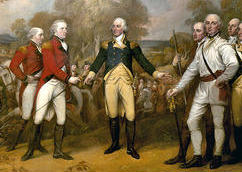
British General Burgoyne surrenders to Continental Army General
Gates at the Battle of Saratoga.
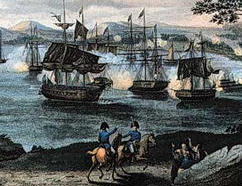
The Battle of Lake Champlain was a battle between ships and
armies in 1814 that ended a British attempt to invade the United States from
the north.
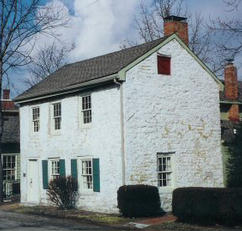
Asahel Wright's home in Centerville, Ohio is now a community center
and
museum of Ohio pioneer life. To visit this
building in Google Earth, click
HERE.
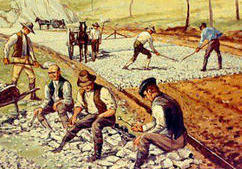
Building the National Road – note the surprising absence of orange
cones.
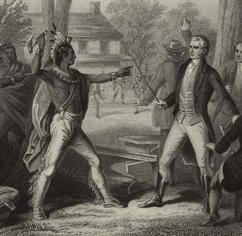
Shawnee leader Tecumseh confronts Governor William Henry Harrison at
Vincennes, Indiana in 1810, protesting the settlers encroachment on
native lands around the Wabash River.
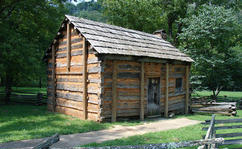
A typical log cabin built by Indiana settlers in the 1820s.
Neighbors marveled that Dan Wright's cabin had a wooden floor.
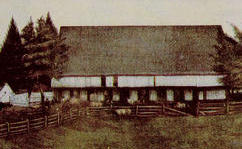
In 1767, there was a "Great Meeting" in Isaac Long's barn near Lancaster,
Pennsylvania. After listening to a passionate speech by Mennonite
preacher Martin Boehm, William Otterbein, a German Reformed pastor,
embraced Boehm and cried "We are all brethren!" This was the
beginning of the Church of the United Brethren, the first religious
sect to emerge on American soil.
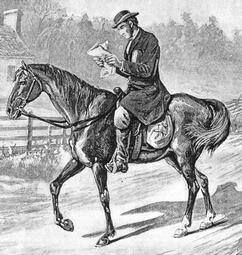
An illustration from the biography of Eli Farmer, a circuit preacher
(or "horse preacher") who served congregations on the Indiana
frontier during the same years at Milton Wright.
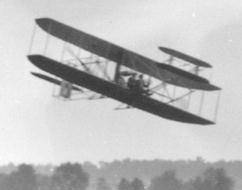
Milton Wright flies with his son Orville at Huffman Prairie in 1910.
|